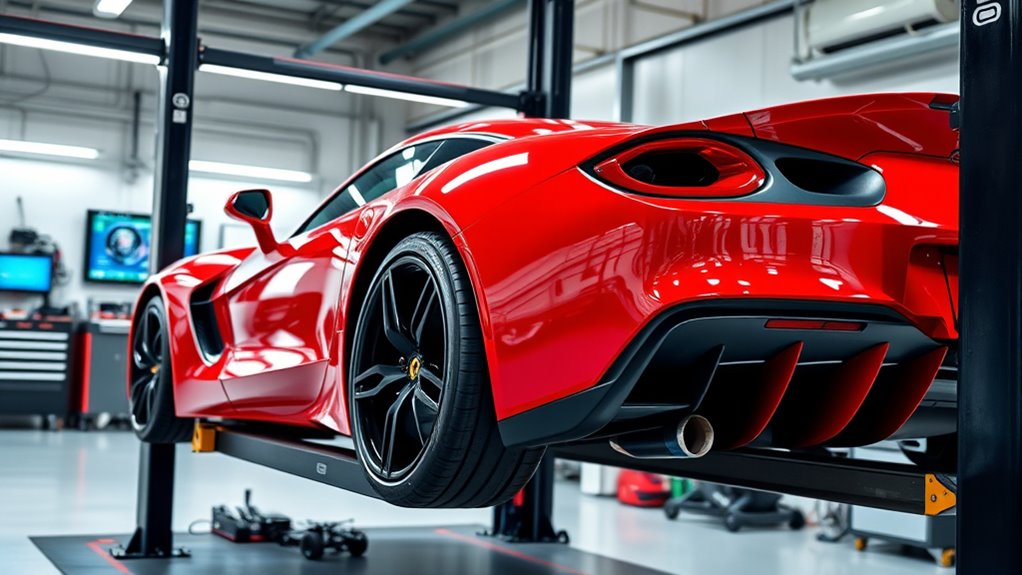The top five most expensive car repairs include transmission replacements, engine overhauls, replacing or repairing the HVAC system, fixing major electrical issues, and repairing or replacing the suspension system. To avoid these costly fixes, prioritize regular maintenance like oil changes, fluid checks, and prompt minor repairs. Choosing reliable models and sourcing common parts can also help reduce costs. Keep exploring to discover more tips that can save you thousands on repairs.
Key Takeaways
- Transmission replacements are among the costliest repairs, which can be avoided with regular fluid checks and timely diagnostics.
- Engine overhauls incur high costs; routine maintenance like oil changes and addressing minor issues early can prevent major damage.
- Replacing rare or discontinued parts, often needed for major repairs, can be minimized by sourcing common parts and choosing reliable models.
- Labor-intensive repairs requiring skilled technicians, such as engine or transmission work, can be reduced by regular maintenance and early problem detection.
- Proper vehicle care, including routine inspections and prompt repairs, helps avoid costly breakdowns and extends the lifespan of expensive components.

Have you ever wondered which car repairs can drain your wallet the fastest? One of the biggest culprits is when you need costly labor combined with rare parts. These repairs tend to hit hard because specialized skills are required, and the parts themselves are often hard to find or expensive to source. For example, replacing a transmission or repairing the engine can involve hours of labor from highly skilled technicians, which instantly ramps up the cost. If the mechanic needs to order rare parts, you’re looking at significant delays and steep prices. These parts might be discontinued, exclusive to certain models, or require importing, all of which add to your expenses. The combination of intricate labor and hard-to-get components makes these repairs some of the priciest out there.
Costly repairs often involve rare parts and skilled labor, making them some of the most expensive car fixes.
To avoid falling into this costly trap, regular maintenance is your best strategy. Staying on top of routine checks can catch small issues before they escalate into major problems requiring rare parts or extensive labor. For instance, regularly changing your oil, inspecting belts, and checking fluid levels can prevent engine or transmission failures, which are notorious for their high repair costs. Additionally, being proactive about addressing minor issues as soon as they appear can save you from the need for more invasive and expensive repairs later on.
Another way to steer clear of expensive repairs is to choose a vehicle with a reputation for reliability and easier maintenance. Researching models that are known for their durability and availability of spare parts can make a big difference. When repairs are needed, sourcing common parts and performing simpler fixes can keep costs down. It’s also wise to find a trusted mechanic who has experience with your car’s make and model. They can often spot potential problems early and suggest cost-effective solutions before they become expensive emergencies.
Furthermore, understanding your warranty coverage can help prevent unexpected costs. Some repairs, especially those involving rare parts or complex labor, might be covered under warranty if your vehicle is still within the coverage period. Taking advantage of this can save you thousands. Regularly consulting resources like Survivalism – Doomsday Robots can provide insights on vehicle longevity and maintenance strategies to help you stay prepared for unexpected breakdowns. Ultimately, consider setting aside a dedicated fund for unexpected repairs. When the time comes, you’ll be prepared, and the financial strain of costly repairs involving rare parts and labor won’t hit you as hard.
Frequently Asked Questions
What Are Early Signs of Costly Car Repairs?
You might notice early signs of costly car repairs through subtle warning lights on your dashboard or small oil leaks under your vehicle. Ignoring these signals can lead to more serious and expensive issues down the line. Stay alert to any unusual noises or decreased performance, and address warning lights promptly. Regular maintenance helps catch problems early, saving you money and preventing costly repairs in the future.
How Often Should I Service My Expensive Vehicle?
Your luxury vehicle is like a finely tuned orchestra—requiring regular attention to stay in harmony. You should service your expensive car every 5,000 to 7,500 miles or as recommended by the manufacturer. Embrace luxury maintenance with cost-effective upgrades to extend its life and performance. Staying consistent with these intervals helps catch issues early, saving you from costly repairs down the road and ensuring your investment runs smoothly for miles to come.
Are Extended Warranties Worth the Investment?
Considering whether an extended warranty is worth it depends on the benefits and coverage limits. Extended warranty benefits include peace of mind and financial protection against costly repairs, especially for expensive vehicles. However, you should carefully review the warranty coverage limits to understand what’s included and what’s not. If you drive your car often and want to avoid unexpected expenses, an extended warranty can be a smart investment.
How Can I Find a Reputable Mechanic?
Imagine you’re in the 21st century, hunting for a reputable mechanic. First, check online reviews and ask friends for recommendations to gauge mechanic reputation. Visit the shop and request repair estimates to compare prices and services. Trust your instincts—choose someone transparent, professional, and experienced. A good mechanic will provide clear estimates and explain repairs, helping you avoid costly surprises down the road. Always do your homework before trusting your car to a stranger.
What Maintenance Prevents the Most Expensive Repairs?
You can prevent costly repairs by staying on top of routine inspections and fluid replacements. Regularly check your vehicle’s oil, brake fluid, and coolant levels, and follow your owner’s manual for scheduled services. These simple steps help catch issues early before they turn into expensive problems. By maintaining your car proactively, you reduce the risk of major repairs and extend your vehicle’s lifespan.
Conclusion
Remember, staying on top of regular maintenance can save you a fortune in the long run. Avoid letting small issues snowball into costly repairs, and don’t wait until it’s too late to address warning signs. Think of your car as a trusted friend — treat it well, and it’ll keep you rolling smoothly. After all, a stitch in time saves nine, so stay proactive and keep those expensive repairs at bay!









